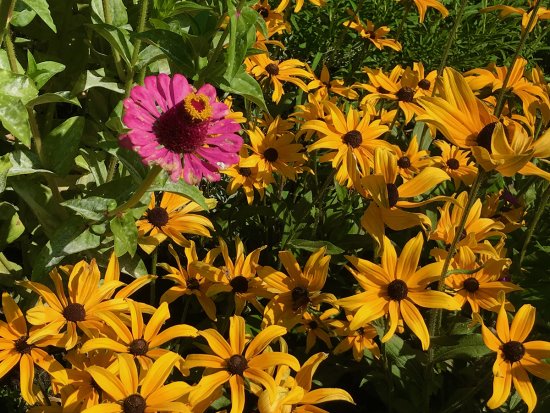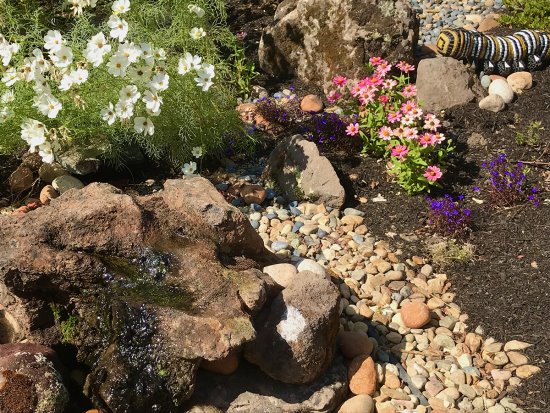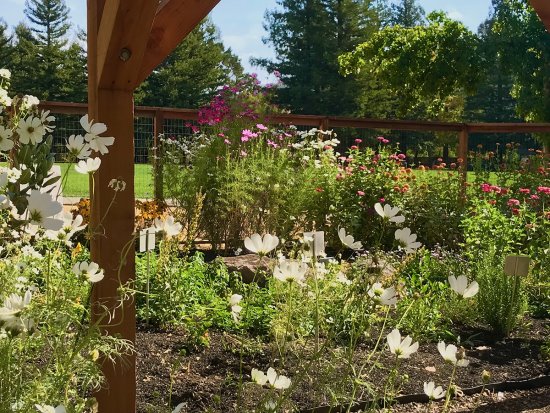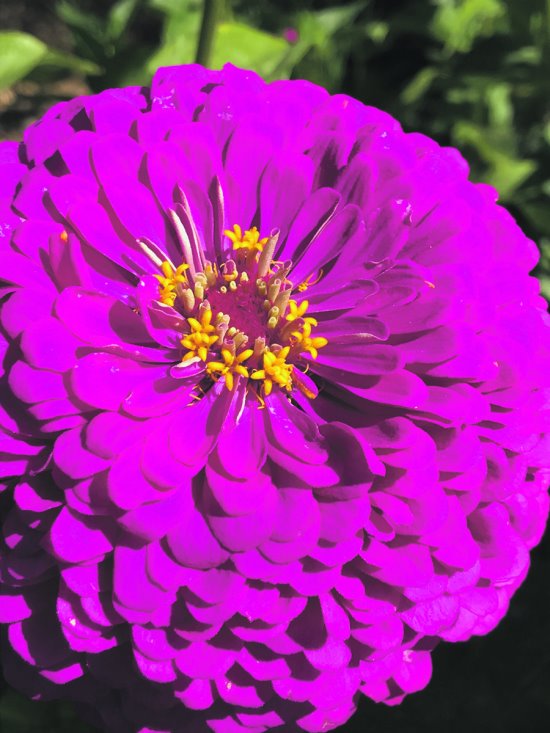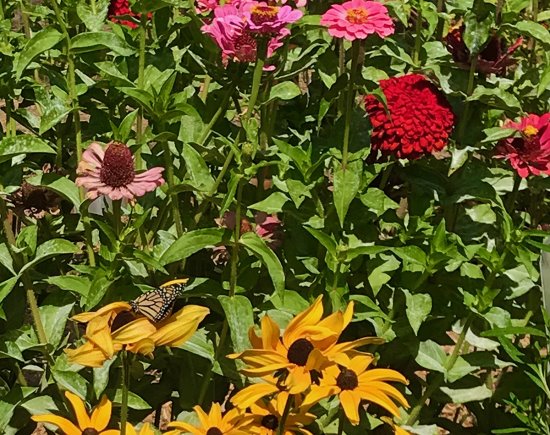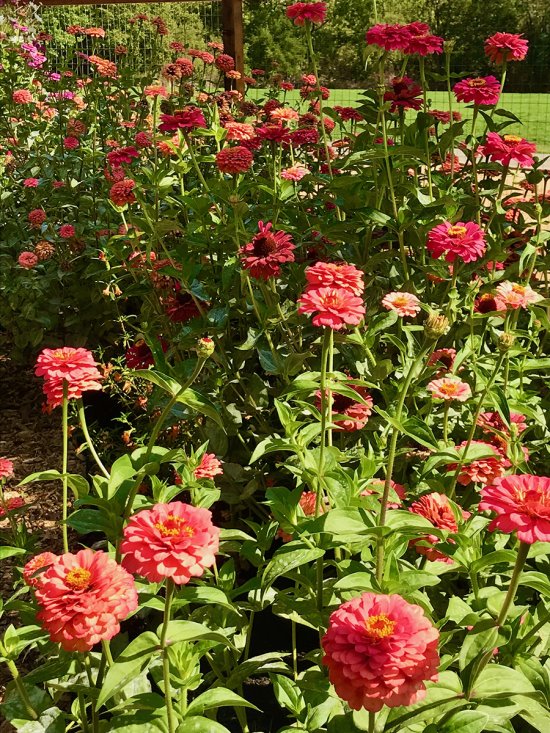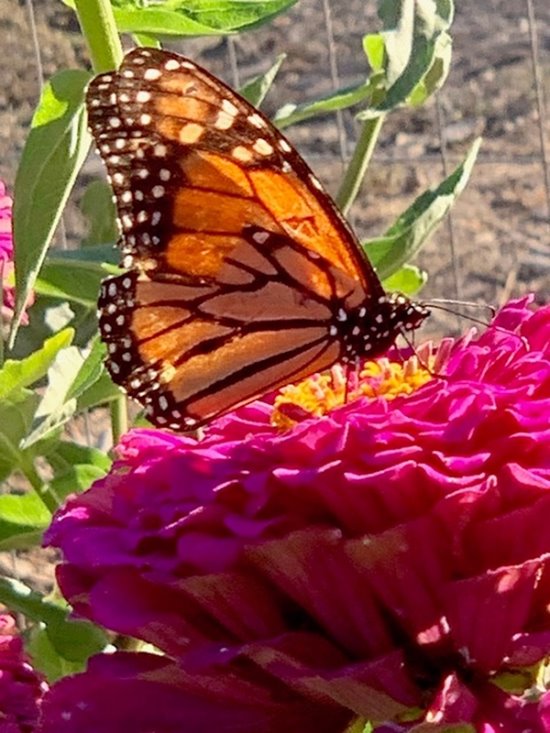 |
|
|
A majestic Monarch lands on a zinnia. Photos Cynthia Brian
|
|
|
|
|
|
"If a butterfly flutters its wings in Brazil, could it cause a tornado in Texas?"~ Edward Lorenz, meteorologist
 Almost everyone has heard of the "butterfly effect." Originally based on weather and climate predictions, it has become a metaphor for the effects of chaos theory - the concept that small events can have huge widespread consequences.
Almost everyone has heard of the "butterfly effect." Originally based on weather and climate predictions, it has become a metaphor for the effects of chaos theory - the concept that small events can have huge widespread consequences.
 As I was driving home from work one late October day and listening to a radio program chronicling the rapid extinction of many species on our planet, I was struck by the comment that 99.9% of Monarch butterflies have vanished from the West Coast.
As I was driving home from work one late October day and listening to a radio program chronicling the rapid extinction of many species on our planet, I was struck by the comment that 99.9% of Monarch butterflies have vanished from the West Coast.
 Only a few years ago, I had enjoyed a glorious November morning in Pismo Beach among thousands of Monarchs fluttering through the gum trees at Monarch Grove.
Only a few years ago, I had enjoyed a glorious November morning in Pismo Beach among thousands of Monarchs fluttering through the gum trees at Monarch Grove.
 Knowing that the Moraga Garden Club had a goal of revitalizing the Monarch butterfly population with its "Moraga for Monarchs" mission, I drove straight to Rancho Laguna Park to investigate the progress of the project. I was blown away at how quickly the area had developed from barren land to a lush, organic, ecologically beneficial beauty basin. The co-founders, Julie Stagg and Bobbie Preston, are quick to point out that this has been a community project of love with support not only from the members of the Moraga Garden Club, but from the town of Moraga, Saint Mary's College, Moraga Garden Center, Moraga Park and Recreation Foundation, numerous service organizations, and wildlife experts.
Knowing that the Moraga Garden Club had a goal of revitalizing the Monarch butterfly population with its "Moraga for Monarchs" mission, I drove straight to Rancho Laguna Park to investigate the progress of the project. I was blown away at how quickly the area had developed from barren land to a lush, organic, ecologically beneficial beauty basin. The co-founders, Julie Stagg and Bobbie Preston, are quick to point out that this has been a community project of love with support not only from the members of the Moraga Garden Club, but from the town of Moraga, Saint Mary's College, Moraga Garden Center, Moraga Park and Recreation Foundation, numerous service organizations, and wildlife experts.
 The "Moraga for Monarchs" goal is simple: repopulate Monarchs throughout town while providing public Monarch habitats, educating citizens, and providing plants to support Monarchs and other pollinators in private landscaping.
The "Moraga for Monarchs" goal is simple: repopulate Monarchs throughout town while providing public Monarch habitats, educating citizens, and providing plants to support Monarchs and other pollinators in private landscaping.
 Following their lead, every gardener can easily invite a bevy of beneficials to take up residence in the garden. Their website is a cornucopia of ever-evolving information about nectar plants, milkweed gardening, building a habitat, as well as supportive plants that are currently being installed in the Rancho Laguna Park Monarch Garden.
Following their lead, every gardener can easily invite a bevy of beneficials to take up residence in the garden. Their website is a cornucopia of ever-evolving information about nectar plants, milkweed gardening, building a habitat, as well as supportive plants that are currently being installed in the Rancho Laguna Park Monarch Garden.
 By first planting nectar plants that bloom February through April followed by Monarch-specific nectar plants for blooming in October and November, a garden will be attractive to pollinators in all seasons. Besides butterflies, bees, birds, hummingbirds, lady beetles, bats, and other helpful insects will be darting and swooping through this nourishing landscape.
By first planting nectar plants that bloom February through April followed by Monarch-specific nectar plants for blooming in October and November, a garden will be attractive to pollinators in all seasons. Besides butterflies, bees, birds, hummingbirds, lady beetles, bats, and other helpful insects will be darting and swooping through this nourishing landscape.
 When I visited, swaths of cosmos in several colors had grown to over eight feet high. Purple, salmon, and chartreuse zinnias shone in the sunlight. Black-eyed Susan, purple verbena, Agastache, lobelia, sage, mints, yarrow, and butterfly bush were hosting bees and butterflies, including several Monarchs. A trickling rock waterfall powered by the sun offers a sweet drink to the flyers. The water feature is flanked by a river rock dry creek that provides a sunning area for the butterflies surrounded by cosmos, zinnias, and lobelia as an artful caterpillar stands watch. Milkweed is growing to feed the caterpillars. Passionflower vines twine up the wooden pergola and wood chip paths meander throughout the plantings. Signage has thoughtfully been installed throughout the beds to instruct visitors on the species planted. The habitat is fenced to keep out hungry predators as well as people. Soon benches will be installed so that visitors can rest and watch. Volunteers maintain the garden, carefully pulling out the insidious bindweed, and lovingly pruning, deadheading and sowing.
When I visited, swaths of cosmos in several colors had grown to over eight feet high. Purple, salmon, and chartreuse zinnias shone in the sunlight. Black-eyed Susan, purple verbena, Agastache, lobelia, sage, mints, yarrow, and butterfly bush were hosting bees and butterflies, including several Monarchs. A trickling rock waterfall powered by the sun offers a sweet drink to the flyers. The water feature is flanked by a river rock dry creek that provides a sunning area for the butterflies surrounded by cosmos, zinnias, and lobelia as an artful caterpillar stands watch. Milkweed is growing to feed the caterpillars. Passionflower vines twine up the wooden pergola and wood chip paths meander throughout the plantings. Signage has thoughtfully been installed throughout the beds to instruct visitors on the species planted. The habitat is fenced to keep out hungry predators as well as people. Soon benches will be installed so that visitors can rest and watch. Volunteers maintain the garden, carefully pulling out the insidious bindweed, and lovingly pruning, deadheading and sowing.
 There is something magical about witnessing the flight of a butterfly as it gathers pollen on its legs and disperses it as it flits from flower to flower. Everyone can enjoy a butterfly waystation next spring by planning now. If you want to erect a Monarch and pollinator oasis, check out the resources provided by the Moraga Garden Club in collaboration with the Xerces Society and Monarch Joint Venture at moragagardenclub.com/moraga-for-monarchs.
There is something magical about witnessing the flight of a butterfly as it gathers pollen on its legs and disperses it as it flits from flower to flower. Everyone can enjoy a butterfly waystation next spring by planning now. If you want to erect a Monarch and pollinator oasis, check out the resources provided by the Moraga Garden Club in collaboration with the Xerces Society and Monarch Joint Venture at moragagardenclub.com/moraga-for-monarchs.
 Here is a list of milkweeds and other plants that you'll want to consider recommended by the Moraga for Monarchs garden.
Here is a list of milkweeds and other plants that you'll want to consider recommended by the Moraga for Monarchs garden.
 MILKWEED
MILKWEED
 It is recommended to only plant California native milkweeds.
It is recommended to only plant California native milkweeds.
 Approved for Lamorinda
Approved for Lamorinda
 Narrow Leaf (Asclepias fascicularis)
Narrow Leaf (Asclepias fascicularis)
 Showy (A. speciosa)
Showy (A. speciosa)
 California (A. californica)
California (A. californica)
 Wooly (A. vesta)
Wooly (A. vesta)
 Heartleaf (A. cordifolia)
Heartleaf (A. cordifolia)
 Not Advised for Lamorinda
Not Advised for Lamorinda
 Common Milkweed (A. syriaca)
Common Milkweed (A. syriaca)
 Butterfly Weed (A. tuberosa)
Butterfly Weed (A. tuberosa)
 Tropical Milkweed (A. curassavica)
Tropical Milkweed (A. curassavica)
 Other Milkweed
Other Milkweed

 SUPPORTIVE PLANTS
SUPPORTIVE PLANTS
 Agastache
Agastache
 Anise Hyssop
Anise Hyssop
 Bee Balm
Bee Balm
 Black-eyed Susan
Black-eyed Susan
 Brodiaea
Brodiaea
 Butterfly Bush
Butterfly Bush
 California Brittlebush
California Brittlebush
 Catmint
Catmint
 Ceanothus
Ceanothus
 Coyote Mint
Coyote Mint
 Coral Bells
Coral Bells
 Cosmos
Cosmos
 Echinacea
Echinacea
 Goldenrod
Goldenrod
 Hairy Gum Plant
Hairy Gum Plant
 Lavender
Lavender
 Liatris
Liatris
 Lithodora
Lithodora
 Lobelia
Lobelia
 Lupine
Lupine
 Meadow Blazing Star
Meadow Blazing Star
 Mint (several)
Mint (several)
 Monkey Flower
Monkey Flower
 Oregon Grape
Oregon Grape
 Passionflower
Passionflower
 Passion Vine
Passion Vine
 Penstemon
Penstemon
 Rosemary
Rosemary
 Salvia
Salvia
 Sage
Sage
 Scarlet Monardella
Scarlet Monardella
 Seaside Daisy
Seaside Daisy
 Snake Lily
Snake Lily
 Sweet Joe Pye Weed
Sweet Joe Pye Weed
 Sunflower
Sunflower
 Tithonia
Tithonia
 Verbena
Verbena
 Yarrow
Yarrow
 Zinnia
Zinnia
 Butterflies may be free, but the Monarch is on the possible extinction list. We all need to do our part to save our planet by saving our pollinators. We already know that bees are dwindling and so many other critical species are endangered. Start pesticide and insecticide-free gardening habits. By being proactive with organic gardening practices and establishing healthy habitats, we will all enjoy our personal paradises while supporting our garden guardians.
Butterflies may be free, but the Monarch is on the possible extinction list. We all need to do our part to save our planet by saving our pollinators. We already know that bees are dwindling and so many other critical species are endangered. Start pesticide and insecticide-free gardening habits. By being proactive with organic gardening practices and establishing healthy habitats, we will all enjoy our personal paradises while supporting our garden guardians.
 I dream that when a butterfly flutters its wings in Lamorinda, it will cause peace throughout the world.
I dream that when a butterfly flutters its wings in Lamorinda, it will cause peace throughout the world.
 Nature lovers are welcome. The Moraga for Monarchs Butterfly Garden is free. For more information on Moraga for Monarchs or to donate, visit https://www.moragagardenclub.com
Nature lovers are welcome. The Moraga for Monarchs Butterfly Garden is free. For more information on Moraga for Monarchs or to donate, visit https://www.moragagardenclub.com
 Happy Gardening. Happy Growing.
Happy Gardening. Happy Growing.
|
| Cynthia Brian, The Goddess Gardener, is available for hire to help you prepare for your winter garden. Raised in the vineyards of Napa County, Cynthia is a New York Times best-selling author, actor, radio personality, speaker, media and writing coach as well as the Founder and Executive Director of Be the Star You Are!r 501 c3. Tune into Cynthia's StarStyler Radio Broadcast at
www.StarStyleRadio.com. Buy copies of her books, including, Chicken Soup for the Gardener's Soul, Growing with the Goddess Gardener, and Be the Star You Are!
www.cynthiabrian.com/online-store. Receive a FREE inspirational music DVD and special savings. Hire Cynthia for writing projects, garden consults, and inspirational lectures.
Cynthia@GoddessGardener.com
www.GoddessGardener.com |

